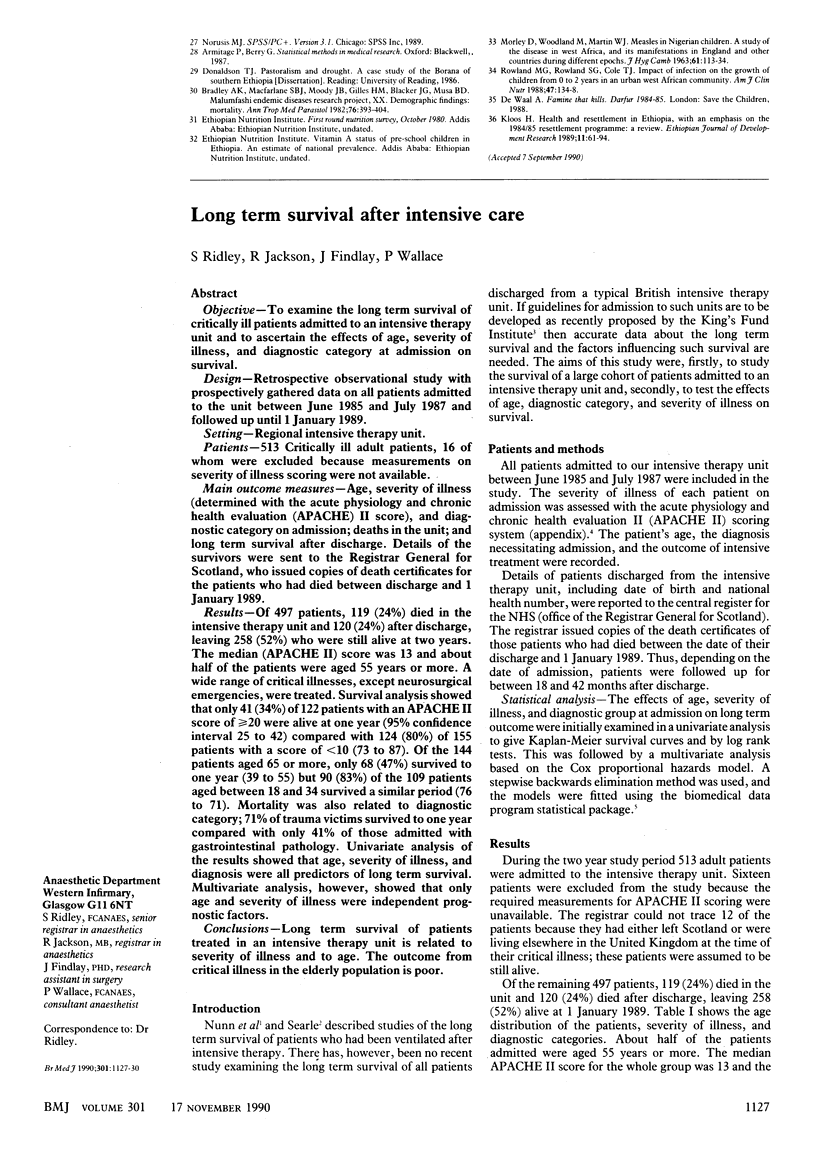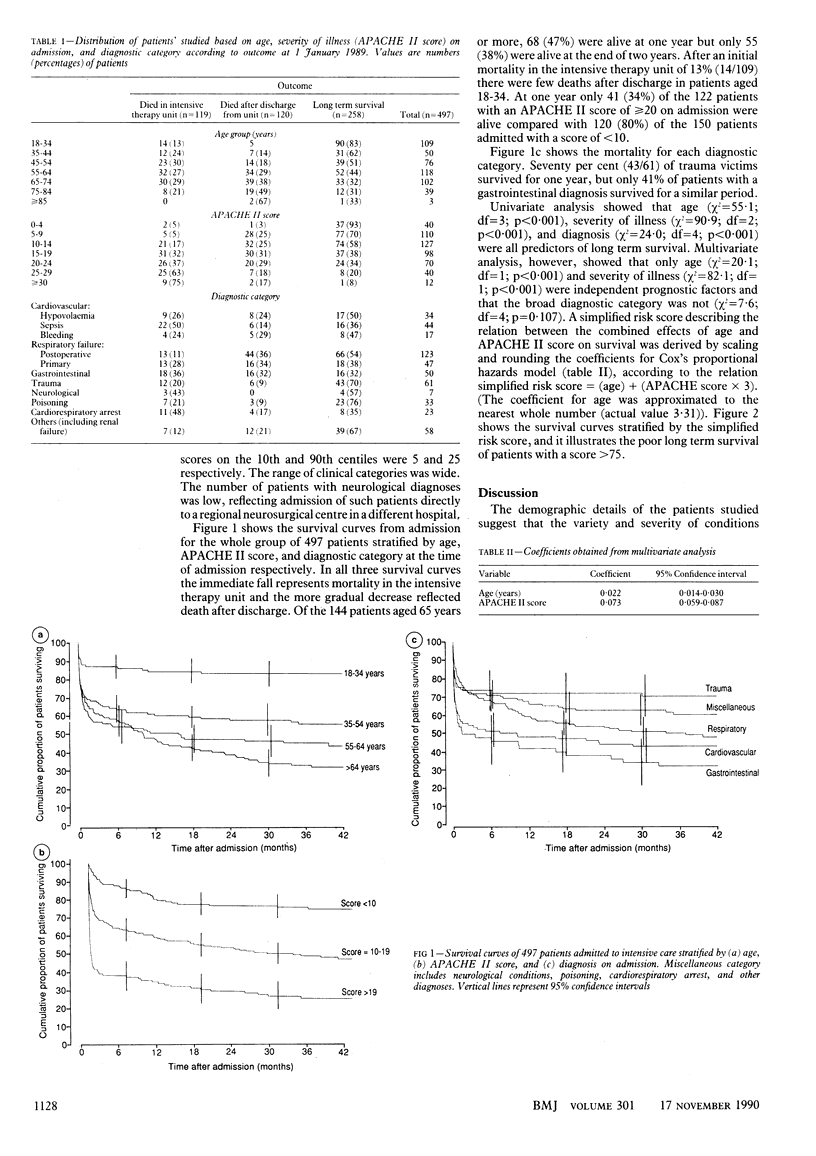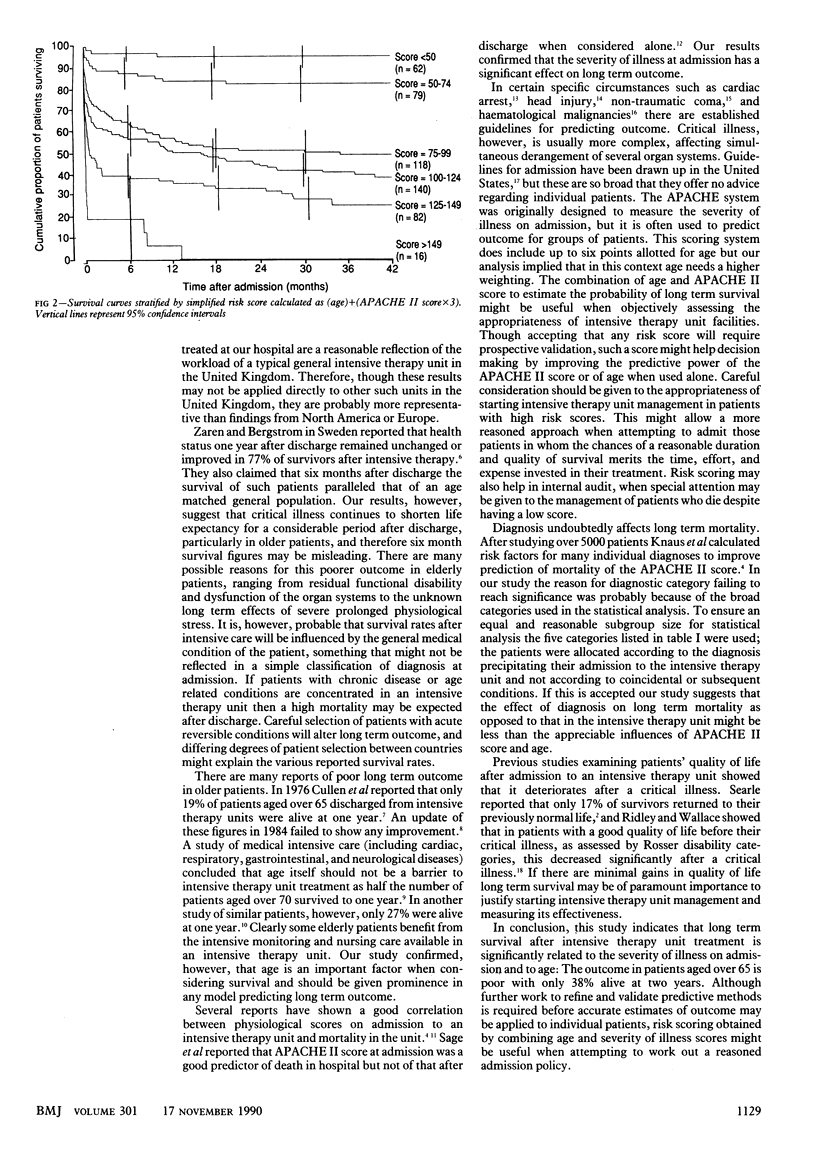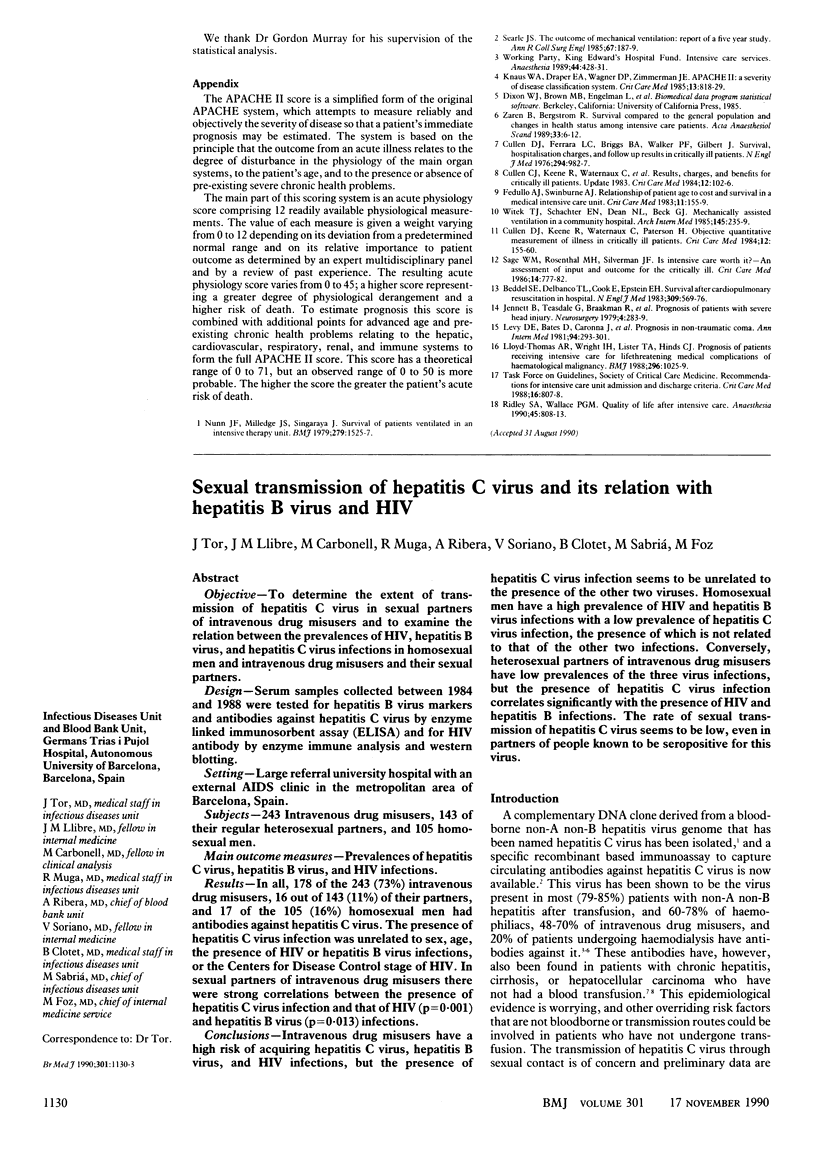Abstract
OBJECTIVE--To examine the long term survival of critically ill patients admitted to an intensive therapy unit and to ascertain the effects of age, severity of illness, and diagnostic category at admission on survival. DESIGN--Retrospective observational study with prospectively gathered data on all patients admitted to the unit between June 1985 and July 1987 and followed up until 1 January 1989. SETTING--Regional intensive therapy unit. PATIENTS--513 critically ill adult patients, 16 of whom were excluded because measurements on severity of illness scoring were not available. MAIN OUTCOME MEASURES--Age, severity of illness (determined with the acute physiology and chronic health evaluation (APACHE) II score), and diagnostic category on admission; deaths in the unit; and long term survival after discharge. Details of the survivors were sent to the Registrar General for Scotland, who issued copies of death certificates for the patients who had died between discharge and 1 January 1989. RESULTS--Of 497 patients, 119 (24%) died in the intensive therapy unit and 120 (24%) after discharge, leaving 258 (52%) who were still alive at two years. The median (APACHE II) score was 13 and about half of the patients were aged 55 years or more. A wide range of critical illnesses, except neurosurgical emergencies, were treated. Survival analysis showed that only 41 (34%) of 122 patients with an APACHE II score of greater than or equal to 20 were alive at one year (95% confidence interval 25 to 42) compared with 124 (80%) of 155 patients with a score of less than 10 (73 to 87). Of the 144 patients aged 65 or more, only 68 (47%) survived to one year (39 to 55) but 90 (83%) of the 109 patients aged between 18 and 34 survived a similar period (76 to 71). Mortality was also related to diagnostic category; 71% of trauma victims survived to one year compared with only 41% of those admitted with gastrointestinal pathology. Univariate analysis of the results showed that age, severity of illness, and diagnosis were all predictors of long term survival. Multivariate analysis, however, showed that only age and severity of illness were independent prognostic factors. CONCLUSIONS--Long term survival of patients treated in an intensive therapy unit is related to severity of illness and to age. The outcome from critical illness in the elderly population is poor.
Full text
PDF



Selected References
These references are in PubMed. This may not be the complete list of references from this article.
- Bedell S. E., Delbanco T. L., Cook E. F., Epstein F. H. Survival after cardiopulmonary resuscitation in the hospital. N Engl J Med. 1983 Sep 8;309(10):569–576. doi: 10.1056/NEJM198309083091001. [DOI] [PubMed] [Google Scholar]
- Cullen D. J., Ferrara L. C., Briggs B. A., Walker P. F., Gilbert J. Survival, hospitalization charges and follow-up results in critically ill patients. N Engl J Med. 1976 Apr 29;294(18):982–987. doi: 10.1056/NEJM197604292941805. [DOI] [PubMed] [Google Scholar]
- Cullen D. J., Keene R., Waternaux C., Kunsman J. M., Caldera D. L., Peterson H. Results, charges, and benefits of intensive care for critically ill patients: update 1983. Crit Care Med. 1984 Feb;12(2):102–106. doi: 10.1097/00003246-198402000-00004. [DOI] [PubMed] [Google Scholar]
- Cullen D. J., Keene R., Waternaux C., Peterson H. Objective, quantitative measurement of severity of illness in critically ill patients. Crit Care Med. 1984 Mar;12(3):155–160. doi: 10.1097/00003246-198403000-00001. [DOI] [PubMed] [Google Scholar]
- Fedullo A. J., Swinburne A. J. Relationship of patient age to cost and survival in a medical ICU. Crit Care Med. 1983 Mar;11(3):155–159. doi: 10.1097/00003246-198303000-00001. [DOI] [PubMed] [Google Scholar]
- Jennett B., Teasdale G., Braakman R., Minderhoud J., Heiden J., Kurze T. Prognosis of patients with severe head injury. Neurosurgery. 1979 Apr;4(4):283–289. doi: 10.1227/00006123-197904000-00001. [DOI] [PubMed] [Google Scholar]
- Knaus W. A., Draper E. A., Wagner D. P., Zimmerman J. E. APACHE II: a severity of disease classification system. Crit Care Med. 1985 Oct;13(10):818–829. [PubMed] [Google Scholar]
- Levy D. E., Bates D., Caronna J. J., Cartlidge N. E., Knill-Jones R. P., Lapinski R. H., Singer B. H., Shaw D. A., Plum F. Prognosis in nontraumatic coma. Ann Intern Med. 1981 Mar;94(3):293–301. doi: 10.7326/0003-4819-94-3-293. [DOI] [PubMed] [Google Scholar]
- Lloyd-Thomas A. R., Wright I., Lister T. A., Hinds C. J. Prognosis of patients receiving intensive care for lifethreatening medical complications of haematological malignancy. Br Med J (Clin Res Ed) 1988 Apr 9;296(6628):1025–1029. doi: 10.1136/bmj.296.6628.1025. [DOI] [PMC free article] [PubMed] [Google Scholar]
- Nunn J. F., Milledge J. S., Singaraya J. Survival of patients ventilated in an intensive therapy unit. Br Med J. 1979 Jun 9;1(6177):1525–1527. doi: 10.1136/bmj.1.6177.1525. [DOI] [PMC free article] [PubMed] [Google Scholar]
- Ridley S. A., Wallace P. G. Quality of life after intensive care. Anaesthesia. 1990 Oct;45(10):808–813. doi: 10.1111/j.1365-2044.1990.tb14560.x. [DOI] [PubMed] [Google Scholar]
- Sage W. M., Rosenthal M. H., Silverman J. F. Is intensive care worth it? An assessment of input and outcome for the critically ill. Crit Care Med. 1986 Sep;14(9):777–782. doi: 10.1097/00003246-198609000-00004. [DOI] [PubMed] [Google Scholar]
- Searle J. F. The outcome of mechanical ventilation: report of a five year study. Ann R Coll Surg Engl. 1985 May;67(3):187–189. [PMC free article] [PubMed] [Google Scholar]
- Witek T. J., Jr, Schachter E. N., Dean N. L., Beck G. J. Mechanically assisted ventilation in a community hospital. Immediate outcome, hospital charges, and follow-up of patients. Arch Intern Med. 1985 Feb;145(2):235–239. [PubMed] [Google Scholar]
- Zarén B., Bergström R. Survival compared to the general population and changes in health status among intensive care patients. Acta Anaesthesiol Scand. 1989 Jan;33(1):6–12. doi: 10.1111/j.1399-6576.1989.tb02850.x. [DOI] [PubMed] [Google Scholar]


